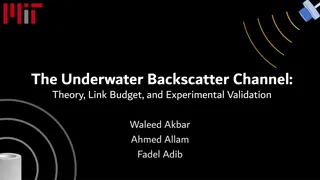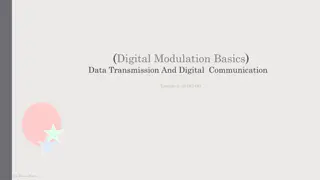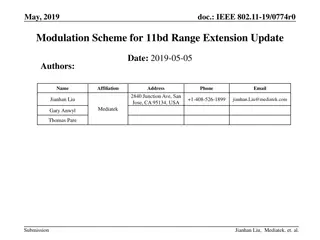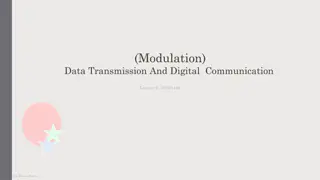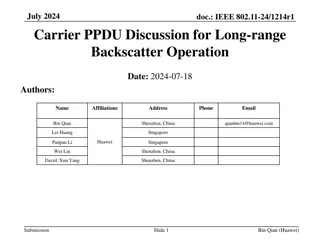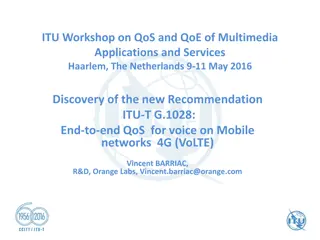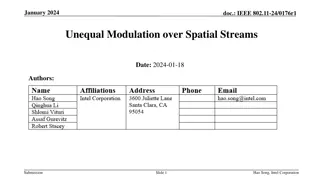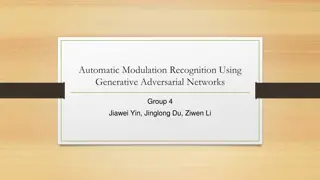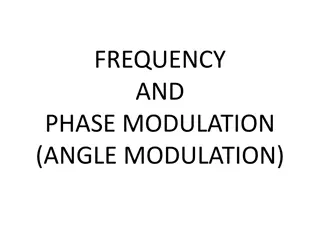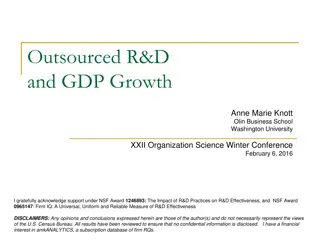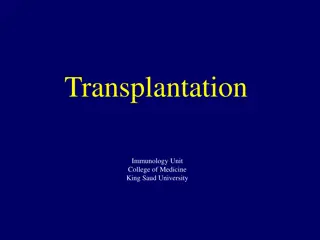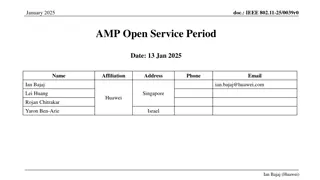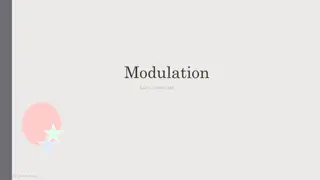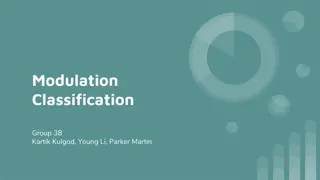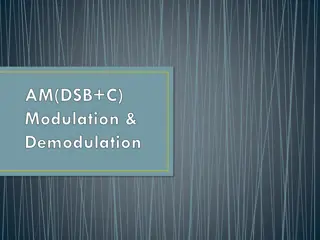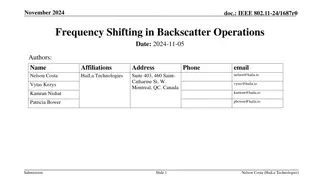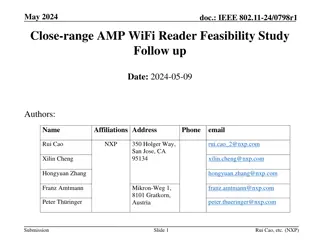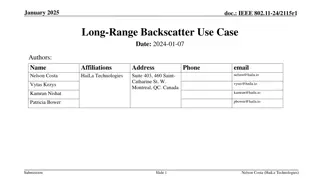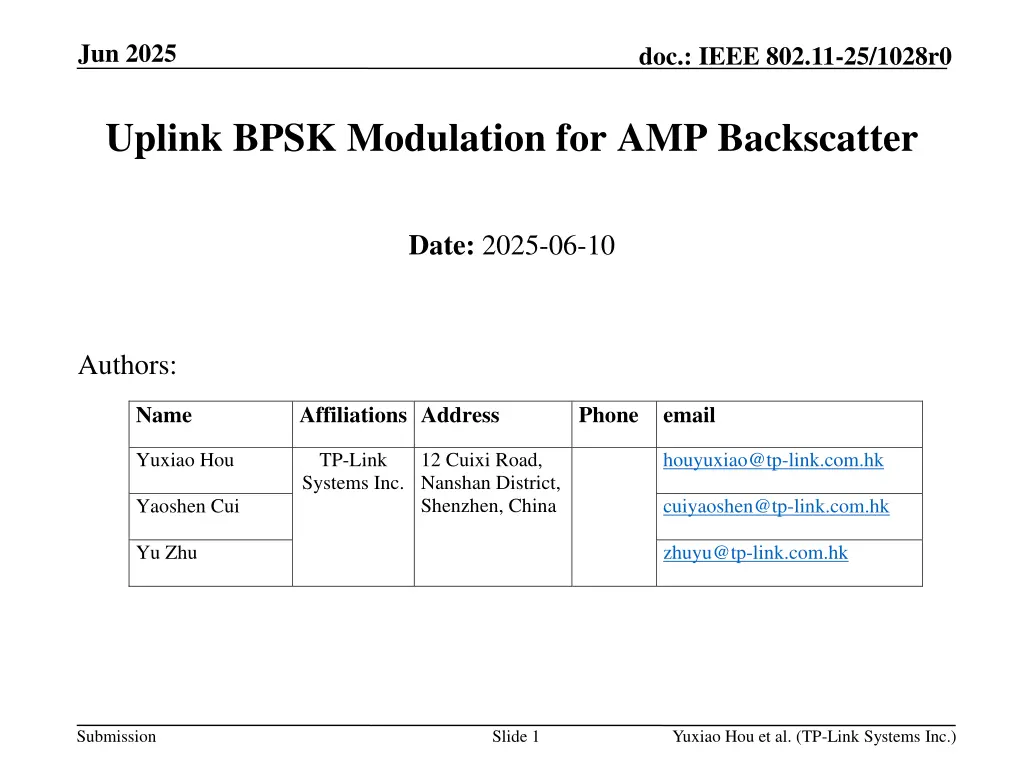
BPSK Modulation for AMP Backscatter in IEEE 802.11-25
Explore the advantages of BPSK modulation over OOK in uplink backscatter communication for AMP devices. Discover the differences in energy absorption rate, transmission range, and resilience against channel impacts. Learn about the implementation of BPSK on tags using RF switches and phase modulation techniques for improved performance.
Uploaded on | 1 Views
Download Presentation

Please find below an Image/Link to download the presentation.
The content on the website is provided AS IS for your information and personal use only. It may not be sold, licensed, or shared on other websites without obtaining consent from the author. If you encounter any issues during the download, it is possible that the publisher has removed the file from their server.
You are allowed to download the files provided on this website for personal or commercial use, subject to the condition that they are used lawfully. All files are the property of their respective owners.
The content on the website is provided AS IS for your information and personal use only. It may not be sold, licensed, or shared on other websites without obtaining consent from the author.
E N D
Presentation Transcript
Jun 2025 doc.: IEEE 802.11-25/1028r0 Uplink BPSK Modulation for AMP Backscatter Date: 2025-06-10 Authors: Name Affiliations Address Phone email Yuxiao Hou TP-Link Systems Inc. 12 Cuixi Road, Nanshan District, Shenzhen, China houyuxiao@tp-link.com.hk Yaoshen Cui cuiyaoshen@tp-link.com.hk Yu Zhu zhuyu@tp-link.com.hk Submission Slide 1 Yuxiao Hou et al. (TP-Link Systems Inc.)
Jun 2025 doc.: IEEE 802.11-25/1028r0 Introduction Discussion on OOK vs. BSPK is recorded in 11-24/2115 and Teleconference Minutes January 2025 [1, 2] On-Off Keying is already selected as the legacy uplink modulation scheme, which is similar to C1G2 RFID protocol. In this presentation, we discuss some advantages of BPSK for uplink backscatter modulation and suggest that AMP device could optionally select either OOK or BPSK. Submission Slide 2 Yuxiao Hou et al. (TP-Link Systems Inc.)
Jun 2025 doc.: IEEE 802.11-25/1028r0 Recap: Discussion on OOK vs. BPSK [1, 2] OOK outperforms BPSK in energy absorption rate. On the other hand, BPSK achieves longer transmission range. Submission Slide 3 Yuxiao Hou et al. (TP-Link Systems Inc.)
Jun 2025 doc.: IEEE 802.11-25/1028r0 OOK vs. BPSK Constellation Map In constellation map, the distance of modulation points for BPSK is twice compared to that for OOK, indicating BPSK achieves approximately twice in SNR compared to OOK, under similar circumstances, which indicates more robustness against channel impacts for BPSK. Compared with amplitude-based modulation, phase-modulation is more robust against channel impacts. Lower SNR for OOK maps to higher BER/PER, or even more retransmission time and hence more energy consumption. Submission Slide 4 Yuxiao Hou et al. (TP-Link Systems Inc.)
Jun 2025 doc.: IEEE 802.11-25/1028r0 Implementation of BPSK on tags Phase modulator consists of several RF Single Pole Double Throw (SPDT) switches organized in a binary tree structure. SPDT switches can pass incoming RF signal to one of the two ports. Switches can be controlled using backscatter data. At leaf nodes, different lengths of RF traces are connected, mapping to different phase shift, e.g., 8PSK in the following figure. The incoming RF signal traverses from the top input port all the way to the selected leaf node and is reflected back from the short circuited terminals to the input RF port. Scalable phase modulator for backscatter tag. Slide 5 Submission Yuxiao Hou et al. (TP-Link Systems Inc.)
Jun 2025 doc.: IEEE 802.11-25/1028r0 Implementation of BPSK on tags The number of SPDT switches is determined by the number of constellation points that are supported. For example, for BPSK only one switch is needed; for QPSK three switches are needed; for 8PSK seven switches are needed; and for 16-PSK 15 switches are needed. Also, if the tag can support higher modulations, then all the lower modulations can also be supported. For example, the design in previous figure can support 8PSK, QPSK and BPSK, by appropriately preventing some of the switches from toggling. Such scalability feature is desired for uplink backscatter rate adaptation when channel condition varies. According to BackFi [3], phase modulator using SPDT RF switches meets ultra-low-power constraints for backscatter tags, in the scale of microwatts. Submission Slide 6 Yuxiao Hou et al. (TP-Link Systems Inc.)
Jun 2025 doc.: IEEE 802.11-25/1028r0 Phase modulation Codeword Translation HitchHike [4] propose codeword translation principle for backscatter 802.11b packets such that commodity Wi-Fi receivers can decode backscatter data. Codeword translation: In principle, 802.11b Wi-Fi protocol bases on phase modulation and uses a finite set of codewords to encode packets. Since in 802.11b protocol only a finite set of codewords are used, if the tag can translate the codeword ????? used by the 802.11b transmitter to another codeword ????? within the same set, then any 802.11b receiver can decode the backscattered packet, with only slight software changes and without hardware modifications. Uplink phase modulation is proper to achieve codeword translation principle as in essence, it rotates the constellation point with a certain angle on the unit circle. Submission Slide 7 Yuxiao Hou et al. (TP-Link Systems Inc.)
Jun 2025 doc.: IEEE 802.11-25/1028r0 Phase modulation Codeword Translation 1 Mbps DSSS transmission: 1 Mbps 802.11b transmission uses only two codewords, code0 and code1, as shown in below equation. Data zero and one are encoded as ????? and ????? respectively. The only difference between the two codewords is a 180 degree phase offset, which indicates whether data zero or one is transmitted. The barker code used by the two codewords is a sequence similar to the PN sequence used in the CDMA system. ?????= ?????? ?????= ?????? ??? 2 Mbps DSSS transmission: 2Mbps 802.11b uses four codewords in its codebook to encode packets. Data 00, 01, 11, and 10 are encoded as ?????, ?????, ?????, and ????? respectively. Again, the data are embedded in the phase of the codewords. ?????= ?????? ??? ?????= ?????? ??? ?????= ?????? ???? ?????= ?????? ? ? Submission Slide 8 Yuxiao Hou et al. (TP-Link Systems Inc.)
Jun 2025 doc.: IEEE 802.11-25/1028r0 Phase modulation Codeword Translation 5.5 Mbps CCK transmission: 5.5 Mbps and 11Mbps CCKs use a larger set of codewords compared to the 1 Mbps and 2 Mbps cases. Equation 3 shows the codewords used by the 5.5Mbps transmission. To transmit at 5.5Mbps, CCK divides the bit stream into blocks of four bits. The first two bits are used to determine the phase of the codeword, which varies among 0, ? ?/2, ? ?, and 3? ?/2. The last two bits are used to choose one of the four barker codes. ?????= ??????? ???? ??????= ???????? ????? 11 Mbps CCK transmission: 11 Mbps CCK transmission uses a similar strategy where the data stream is divided into blocks of 8 bits. Then, the first two bits are used to select the phase, and the last six bits are used to choose one of the 64 Barker codes. Submission Slide 9 Yuxiao Hou et al. (TP-Link Systems Inc.)
Jun 2025 doc.: IEEE 802.11-25/1028r0 Summary Compared with OOK, the lower uplink energy absorption rate of BPSK is balanced with its longer transmission range, higher SNR in constellation map and hence lower error rate. Implementation of BPSK, QPSK, 8PSK using SPDT switch is of simple & scalable architecture and meets ultra-low-power constraint for AMP device. To enable commodity Wi-Fi devices supporting 802.11b standards to decode backscatter symbols with only slight software modifications, codeword translation feature is necessary for uplink backscatter, which further requires phase-based modulation with its constellation points are on the unit circle. Submission Slide 10 Yuxiao Hou et al. (TP-Link Systems Inc.)
Jun 2025 doc.: IEEE 802.11-25/1028r0 References [1] 11-25-2115. Long Range Backscatter Use Case. [2] 11-25-0054r0. Teleconference Minutes January 2025. [3] Dinesh Bharadia, Kiran Joshi, Manikanta Kotaru, Sachin Katti. BackFi: High Throughput WiFi Backscatter. In ACM SIGCOMM, 2015. [4] Pengyu Zhang, Dinesh Bharadia, Kiran Joshi, Sachin Katti.. HitchHike: Practical Backscatter Using Commodity WiFi. In ACM Sensys, 2016. Submission Slide 11 Yuxiao Hou et al. (TP-Link Systems Inc.)
Jun 2025 doc.: IEEE 802.11-25/1028r0 SP Do you agree that 11bp defines BPSK, along with OOK, as an option for uplink backscatter modulation? Submission Slide 12 Yuxiao Hou et al. (TP-Link Systems Inc.)

